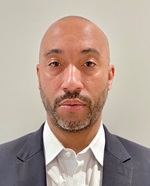Diversity is an outcome, not an input
 People often think of diversity as an input rather than an outcome, Harris (left) said. The key to increasing diversity is to focus on the organizational culture and put inclusion first. The right perspectives also need to be in the room. This means creating psychologically safe spaces for people to bring their full selves to work. This also means leaders need to check in with their team members, especially their often underrepresented Black and African American employees, proactively and regularly, to see how included they feel.
People often think of diversity as an input rather than an outcome, Harris (left) said. The key to increasing diversity is to focus on the organizational culture and put inclusion first. The right perspectives also need to be in the room. This means creating psychologically safe spaces for people to bring their full selves to work. This also means leaders need to check in with their team members, especially their often underrepresented Black and African American employees, proactively and regularly, to see how included they feel.
So what happens when progress doesn’t seem possible in the current environment, especially when it comes to hiring talent? Moore-Roberts likened an organization’s culture to an organism: You need to build antibodies, incubation systems or protective support structures for Black and African American and other underrepresented talent to survive until the system is ready for them. “We have to be honest with candidates about what they’re walking into,” said Moore-Roberts. Some may view that change-resistant environment as a welcome challenge; others may quickly become drained and leave.
DEI&B requires bold action — and is better for business
 Besides it being the right thing to do, organizations that fail to improve the employee and consumer experience for Black and African Americans risk leaving a major opportunity on the table. According to Stewart (left), there is currently $700 billion of untapped value that can be shared across consumers and businesses in the community; by 2030, African Americans will have $1.7 trillion in annual spending power.
Besides it being the right thing to do, organizations that fail to improve the employee and consumer experience for Black and African Americans risk leaving a major opportunity on the table. According to Stewart (left), there is currently $700 billion of untapped value that can be shared across consumers and businesses in the community; by 2030, African Americans will have $1.7 trillion in annual spending power.
Additionally, a $220 billion wage gap exists right now for Black and African American workers, and much of that gap stems from professions that are pathways to the middle class, but take ample investment to pursue, such as law and medicine. To help right these inequalities, Stewart says companies will need to act boldly: “What is the bold thing you will do that’s risky for you? What clients are you willing to walk away from?”
Changes to talent management systems are critical
Organizations also need to look at talent and individual potential differently to confront biases. Biases don’t need to be active and conscious to have a negative effect on how leadership decisions are made. Furthermore, the impact of biases on the talent pool has a cumulative impact over time, reducing the diversity of the leadership pipeline at every level. It is important to be clear about what is — and what is not — a requirement for success in the role. For example, Harris notes that an emphasis on technical parts of the job can be used to exclude people of color and recommends giving more weight to lived experiences. He leveraged those who lost service sector jobs at the onset of the pandemic for contact tracer roles during the height of COVID-19 and many have remained in the healthcare industry.
Moore-Roberts recommended rethinking how candidates are presented to demonstrate their unique value proposition, such as their cross-cultural experience. In addition, effective organizations not only attract talent from diverse backgrounds, they set up paths for high potentials of every background to succeed and retain these leaders at higher rates.
What advocates and allies can do
While advocates and allies can feel empathetic about racial inequality, that’s not enough. “Let's move from feeling guilty to feeling responsible,” said Harris. “That (guilt) doesn't help our people and doesn't advance the cause.” When progress seems slow, create and celebrate small wins. In addition, understand your KPIs, which need to come from the top.
Sometimes, you have to take uncomfortable positions. Stewart suggests that when met with resistance, lean into the wins and convey that it’s not a zero-sum game. “This is a hard topic, so give colleagues courage to have conversations by giving them the facts,” he said. When someone doesn’t appreciate the importance of inclusion, belonging and diversity, Harris advises building relationships. “If you have someone who doesn’t see the light, see them and help them see that you see them. Pay attention to the feelings underneath all the words, pinpoint when those feelings are unproductive and try to move it to a productive space, and always remind people of the big goals, celebrate the small wins along the way, and never ever give up."